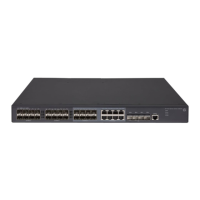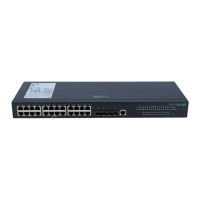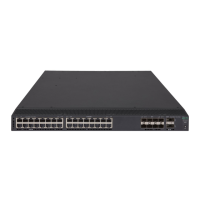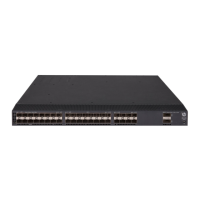180
The value for the vlan-id2 argument must be equal to or greater than the value for the vlan-id1
argument.
tagged: Configures the port as a tagged member of the specified VLANs. A tagged member of a
VLAN sends packets from the VLAN without removing VLAN tags.
untagged: Configures the port as an untagged member of the specified VLANs. An untagged
member of a VLAN sends packets from the VLAN after removing VLAN tags.
Usage guidelines
A hybrid port can allow multiple VLANs. If you execute this command multiple times on a hybrid port,
the hybrid port allows the VLANs specified by the vlan-id-list argument in each execution.
• The configuration made in Layer 2 Ethernet interface view applies only to the port.
• The configuration made in Layer 2 aggregate interface view applies to the aggregate interface
and its aggregation member ports.
{ If the system fails to apply the configuration to the aggregate interface, it stops applying the
configuration to aggregation member ports.
{ If the system fails to apply the configuration to an aggregation member port, it skips the port
and moves to the next member port.
Examples
# Configure GigabitEthernet 1/0/1 as a hybrid port, and assign it to VLAN 2, VLAN 4, and VLANs 50
through 100 as a tagged member.
<Sysname> system-view
[Sysname] interface gigabitethernet 1/0/1
[Sysname-GigabitEthernet1/0/1] port link-type hybrid
[Sysname-GigabitEthernet1/0/1] port hybrid vlan 2 4 50 to 100 tagged
Related commands
port link-type
port link-type
Use port link-type to configure the link type of a port.
Use undo port link-type to restore the default link type of a port.
Syntax
port link-type { access | hybrid | trunk }
undo port link-type
Default
Any port is an access port.
Views
Layer 2 Ethernet interface view, Layer 2 aggregate interface view
Predefined user roles
network-admin
Parameters
access: Configures the link type of a port as access.
hybrid: Configures the link type of a port as hybrid.
trunk: Configures the link type of a port as trunk.

